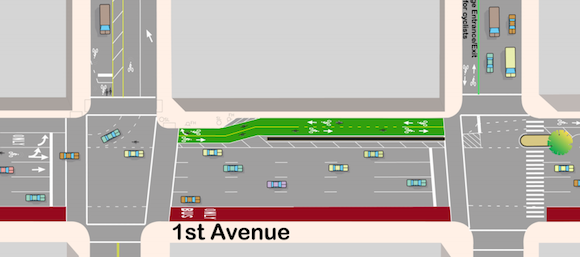
At a meeting of the Community Board 6 transportation committee last night, NYC DOT presented a plan to add some protection for cyclists heading to and from the Queensboro Bridge in Manhattan [PDF]. The proposal would add a protected bike lane on First Avenue between 59th Street and 61st Street, including a two-way segment on one block that will divert southbound bike traffic away from a hectic block of Second Avenue. The project could be implemented as early as this summer.
Cyclists exiting the Queensboro Bridge reach ground level at 60th Street and First Avenue. Presently, southbound cyclists are supposed to travel north on First Avenue, west on 61st Street, then south on Second Avenue, where they must navigate busy bridge entrances between 59th and 60th Streets.
Under DOT's proposal, southbound cyclists would instead use a jersey barrier-protected two-way bike lane on First Avenue between 60th and 59th Streets, connecting to a shared lane on 59th Street. Before reaching Second Avenue, all westbound car traffic on 59th Street diverts to a Queensboro Bridge ramp, after which the bike route would continue as a contra-flow buffered lane with flexible barriers to protect cyclists from oncoming eastbound traffic.

The plan would also add a one-way protected bike lane on First between 60th and 61st, linking the bridge path entrance to the existing northbound protected bike lane on First Avenue.
The proposal would not close the gaps in protected bike lanes on the East Side. Instead it calls for shared lane markings on Second Avenue from 59th Street to 58th Street, and on First Avenue from 56th Street to 59th Street. The shared lanes on First would direct cyclists to the third lane from the left, since there are double left turn lanes there now. This is different than existing shared lane markings on Second Avenue at 36th Street, for example, where left-turning traffic going to the Queens-Midtown Tunnel shares a lane with cyclists continuing straight on Second Avenue.
At last night's meeting, some in attendance raised concerns about cycling in a shared lane removed from the edge of the street on both 59th Street and First Avenue. Committee members requested that DOT consider installing flexible barriers to separate bikes and left-turning vehicles from through lanes, according to Steve Vaccaro. A similar set-up exists at the entrance to the Holland Tunnel on Varick Street.
The committee is next scheduled to meet on Monday, May 6. DOT staff said last night that the plan could be implemented in the summer or fall, if the agency receives a supportive vote from the community board next month.
Also last night, DOT presented preliminary plans for traffic calming around P.S. 347, on East 23rd Street between Second and Third Avenues. This plan would bring sidewalk extensions and pedestrian countdown signals to the area surrounding the school, which serves many deaf students.
The committee also voted 11-1 in favor of a resolution that encourages the MTA to reinstate flashing blue lights on Select Bus Service vehicles. The lights were turned off by the MTA after complaints from Council Member Vincent Ignizio and State Senator Andrew Lanza of Staten Island. State law restricts flashing blue lights to the vehicles of volunteer firefighters and select emergency vehicles. A bill sponsored by Assembly Member Micah Kellner could allow the MTA to turn the lights back on.





